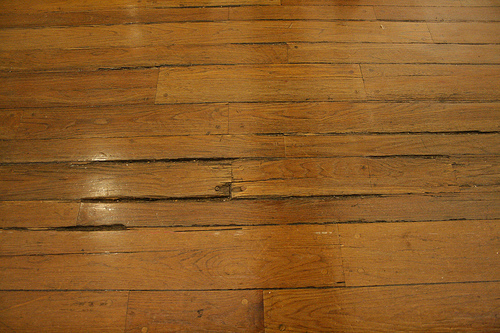How to Fix a Warped Wood Floor
A warped wood floor can be a huge bummer for anyone. The idea that you may need to tear up your warped floor and spend lots of money you don't have tends to be really stressful. But don't fill your head with pictures of pried-up planks and dollar signs spilling out of your ears just yet. The issue may not be as terrible as you think. Find out why.
Moisture Damage to Wood Floors
What causes a wood floor to warp? Usually, it's due to humidity or moisture. This can be caused by changes in temperature and the issue often occurs during a seasonal transition. Water, as with just about any household issue, is almost always the cause of hardwood floor warping.
Warping and cupping are the two main types of floor damage and each cause varying degrees of deterioration.
Cupping
Cupping, also known as wash-boarding, is the milder form of floor damage. Picture a typical wooden floor plank. If the edges along the entire length of the plank curl up and the middle sinks down, that's cupping. This is caused by a moisture imbalance, specifically when there is more moisture on the bottom of the wood pieces than on the top. For example, if the air in the room is quite dry (as it can become during the winter, or because of air conditioning in the summer) and/or there is moisture trapped under the floor (from a spill or even residual condensation), your floor will be at risk of cupping.
Cupped flooring looks bad but it’s almost always reversible. It can usually be corrected by simply restoring proper humidity inside the room, which will help balance out the moisture above and below the flooring.
Warping
Warping causes much more damage to your floors than cupping does. It can manifest in various forms of plank disfigurement, and should be taken very seriously. Most often, a warped wood floor is caused by standing water or heavy moisture below the floor, due to an unidentified leak or other hidden water source. Sometimes, even a nearby water source, like flooding underneath the house, can cause enough of a moisture imbalance to result in warping.
Find the Water Source
If you’re dealing with hardwood floor warping or cupping, the first thing to do is locate the water source. Is there a leak somewhere? Was there a spill that never got cleaned? Could excessive water from mopping have seeped into the sub-flooring? Is there standing water nearby, flooding in the basement or under the home? All of these can cause warping as moisture is absorbed by the planks.
Fix Cupping and Minor Warping
In order to fix cupping and minor warping, you’ll need to change the balance of humidity in the room. In summer, you can try running fans in the windows to blow warm air into the room. Turn off the AC, which only further dries the air. It's important to set up a dehumidifier in the basement or crawlspace directly underneath the damaged area. This will pull moisture out of the air and help dry out the affected planks.
Serious Warping
If your flooring does not return to normal after this method, then you’re dealing with serious warping which will probably require removal and replacement. Luckily, this does not mean you have to replace your entire floor. You can “steal” planks from an inconspicuous place like a closet or under the refrigerator. These stolen planks will be a perfect match to your original flooring, and thus they make the best replacements. You can then compensate for the stolen planks with the closest match you can find.
A warped wood floor can be aggravating, but it doesn't have to mean the end of the world...or your wallet. It’s often just a matter of creative problem solving and playing around with humidity! If necessary, you can always call a professional to solve the problem.
Looking for a Pro? Call us (866) 441-6648

Flooring Average Costs
Flooring Contractors Experiences

Bathroom Flooring Replacement And A Mystery Solved

New Vinyl And Hardwood Flooring To Replace Water Damaged Floors




